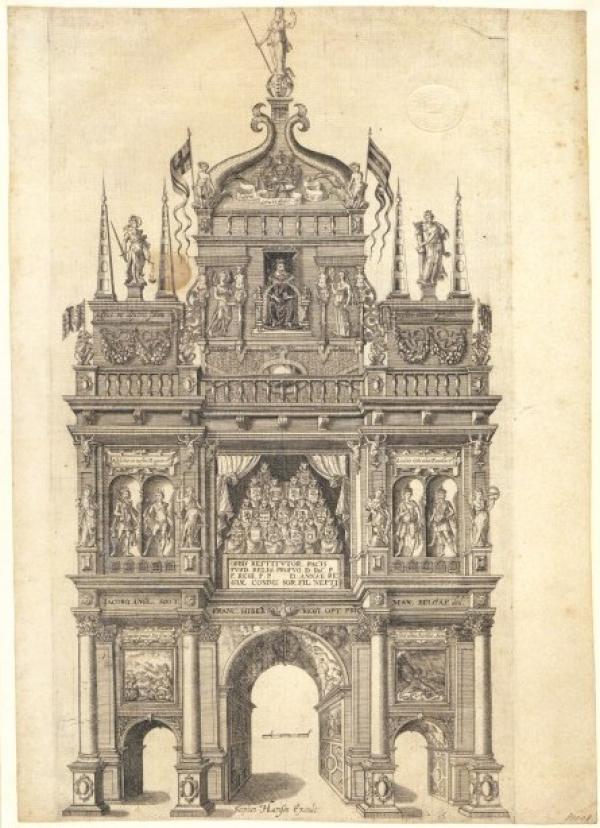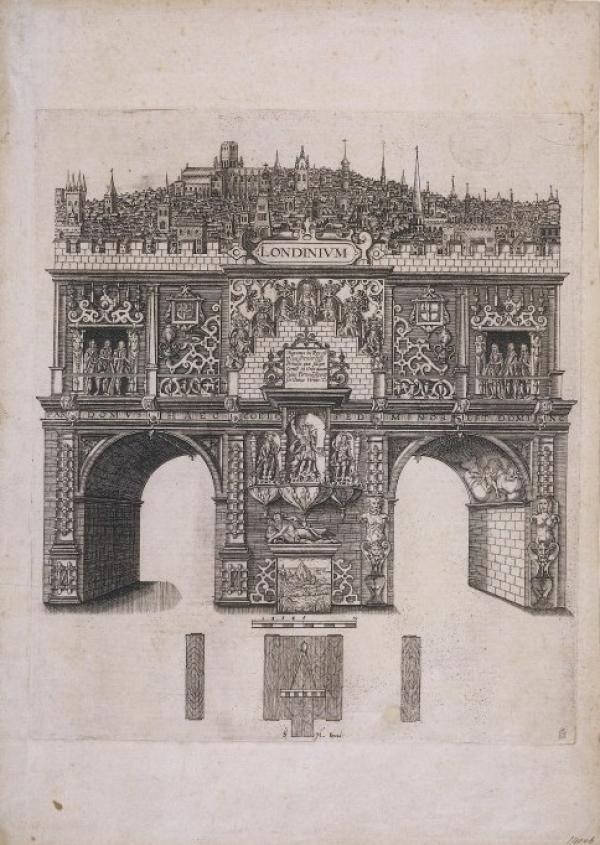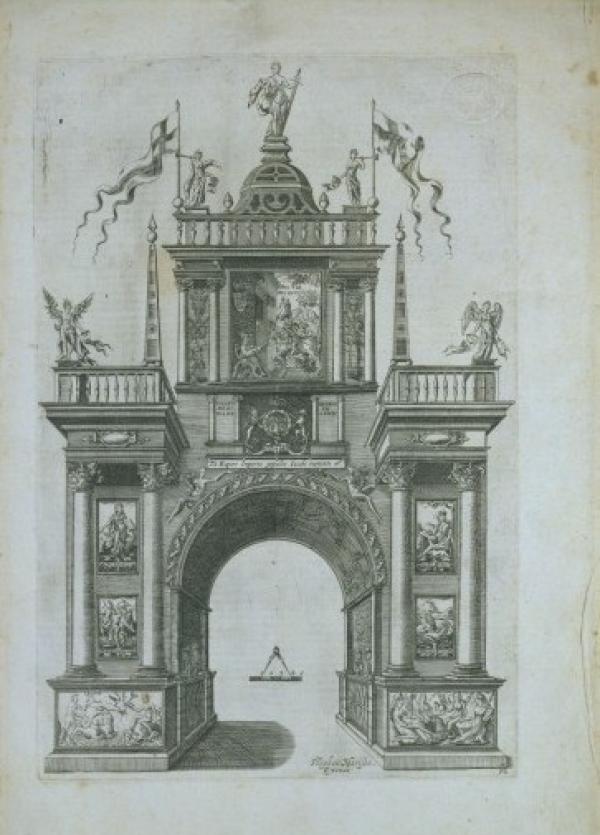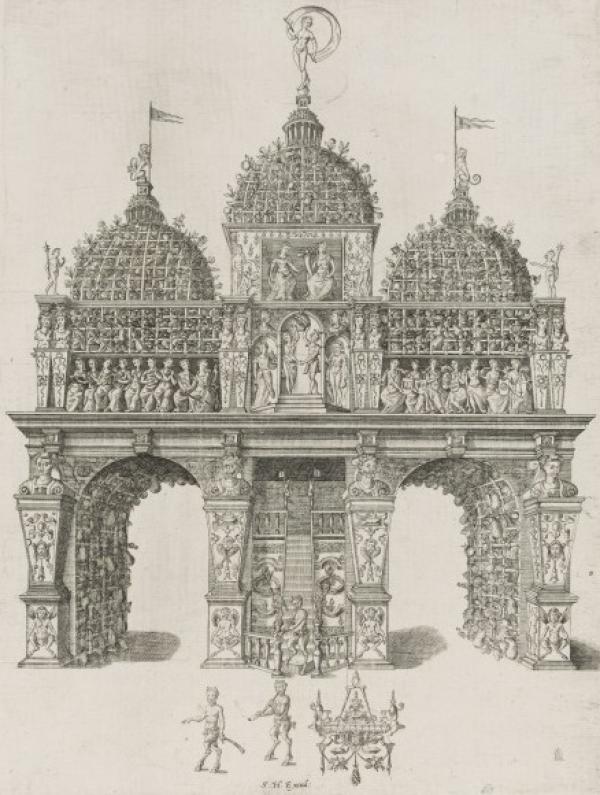During the first weekend of June 2012 Britain will embrace a mood of celebration as it celebrates the Queen’s Diamond Jubilee. The festivities will include street parties throughout the country and the Regatta on Sunday 3rd June will be one of the largest flotillas ever assembled in London on the river Thames.
Such celebrations have long been a tradition of both the jubilees and coronations of the British monarchy. A series of eight engravings by William Kip after the designs of Stephen Harrison in the V&A collection documents one such event, the pageant held on the 15th March 1604 for the entry of King James I into Parliament.

Figure 1. V&A inventory number 14008, William Kip after Stephen Harrison, The Arch of the Dutchmen.
King James VI of Scotland (1566-1625) ascended to the English throne at the death of Queen Elizabeth I on the 24th March 1603. Almost immediately pageants were planned for the King’s passage through the city on his route to the Tower of London, the traditional place of preparation for coronation. The joiner and architect, Stephen Harrison, was commissioned to design a series of triumphal arches that would be erected at the key points along this procession. However an outbreak of the plague in the spring of that year deferred the king’s coronation until July. [2] With the plague still running rife in the capital, the coronation celebrations were more dubdued than first planned. It was not until the following year, once the plague had passed and crowds could safely gather, that Harrison’s seven triumphal arches were erected, this time for the King’s passage on the 15th March 1604 to his first parliament.

Figure 2. V&A 14006, William Kip after Stephen Harrison, The Arch of Londinium
Each of the arches represents a particular theme and was used as a backdrop for musical performances and orations by some of the finest writers of the day, including Ben Jonson. Such elaborate spectacles, which often combine complex allegorical themes, provide an insight into early seventeenth-century ideas of Britain and its monarchy.
The first arch along the route stood at Fenchurch and represented the city of London. It is described by contemporary sources as being 50 feet high and having models of houses, turrets and steeples of London decorating its roof (see figure 2). The pageant performed at this arch showed the personification of British Monarchy at the feet of whom sat the personifications of Divine Wisdom and Genius of the City. Other figures included Gladness, Veneration, Prompitude, Vigilance, Loving Affection and Unanimity, in classical dress; conveying the characteristics that monarchy embodied in early seventeenth-century Britain.

Figure 3. V&A 14010, William Kip after Stephen Harrison, The Arch of the Italians
The next two arches were commissioned by two groups of foreign residents of London and were designed independently of Harrison’s arches. The first of these was the Arch of the Italians, erected on Gracious Street (figure 3). Here a panel at the top of the arch showing King Henry VII seated with James I approaching on horseback to receive the crown of England, symbolises his succession to the throne. [3] This was followed by the Arch of the Dutchmen at the Exchange. Here women dressed in local costume symbolised the seven provinces of Belgia while paintings represented the husbandary of various manual arts of Holland.

Figure 4. V&A 14011, William Kip after Stephen Harrison, The Arch of the Bower of Plenty
Continuing the theme of a successful reign the fifth arch representing the Bower of Plenty stood at Little Conduit in Cheapside (see figure 4). Designed as a garden with domes constructed of trellis bearing flowering plants, the arch was adorned with figures representing Peace, Plenty, Chrusos (Gold) and Argurion (Silver) at the top centre of the arch. The nine muses were placed seated below to the left whilst on the right were the seven liberal arts: Grammar, Logic, Rhetoric, Music, Arithmetic, Geometry and Astrology. The flourishing garden and allegorical figures all combine to create a bountiful spectacle anticipating a time of prosperity and plenty for the country.
Although elaborate processions and pageants had been held before for the monarchy as Harrison writes in his address to the reader, this is the first time that such celebrations of an English king had been published in a series of engravings. Little is known about Harrison other than his being documented as a joiner in Middlesex and as the designer of the above arches produced for the pageant held for King James VI in 1604. The fact that he chose to publish these prints as a souvenir of the day suggests that he was an acute businessman as well as master craftsman. The prints were published and bound in a book with explanations of each arch given on the facing page to the illustration. Although these temporary triumphal arches have long since disappeared, Kip’s engravings after Harrison’s designs offer a precious insight into the visual spectacle held in honour of King James I. It appears that Harrison published these engravings with this purpose in mind; as he writes in his address to the reader that the memory of this pageant in these prints was ‘here newe wrought up again and shall endure forever.’
Footnotes
1. Stephen Harrison, from Dedication to Sir Thomas Bennett, Knight, Lord Mayor, Arch’s of Triumph, London 1604.
2. John Gough Nichols, London Pageants: Accounts of 60 Royal Processions and Entertainments in the City of London, London, 1831, p.63.
3. King James I was descended from Henry VII both on his maternal and paternal side.